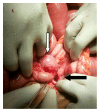A Rare Type of Primary Internal Hernia Causing Small Intestinal Obstruction
- PMID: 27999703
- PMCID: PMC5141326
- DOI: 10.1155/2016/3540794
A Rare Type of Primary Internal Hernia Causing Small Intestinal Obstruction
Abstract
Primary internal hernias are extremely rare in adults. They are an important cause of small intestinal obstruction and lead to high morbidity and mortality if left untreated. Clinical presentation of internal hernia is nonspecific. Imaging has been of limited utility in cases of acute intestinal obstruction; moreover, interpretation of imaging features is operator dependant. Thus, internal hernias are usually detected at laparotomy and preoperative diagnosis in an emergency setting is either difficult or most of the time not suspected. We report herein a case of a 45-year-old male who presented with acute intestinal obstruction which was attributed later to a very rare type of internal hernia on exploratory laparotomy. A loop of ileum was found to enter the retroperitoneum through a hernia gate which was located lateral to the sigmoid colon in the left paracolic gutter. The segment of intestine was reduced and the hernial defect was closed. Our finding represents an extremely rare variant of retroperitoneal hernias.
Conflict of interest statement
The authors declare that there is no conflict of interests regarding the publication of this paper.
Figures



References
-
- Rae A., Kalyanaraman A., Ward A., Harikrishnan A. An interesting case of retrocaecal internal herniation causing small bowel obstruction. Annals of Medicine and Surgery. 2015 doi: 10.1016/j.amsu.2015.06.001. - DOI
LinkOut - more resources
Full Text Sources
Other Literature Sources

